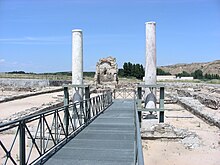Carranque (Archaeological Park)
The Archaeological Park at Carranque includes several remains of a villa rustica from the late Roman period in Spain. The site was discovered in 1983 by the farm worker Samuel López Iglesias.
location
The site is about 3 km west of the town of Carranque (about 50 km north of Toledo and about 45 km southwest of Madrid ) on an old Roman road in the province of Toledo in the autonomous region of Castile-La Mancha in the immediate vicinity of the Río Guadarrama , whose banks are covered with lush vegetation.
building
The preserved foundation walls of the three buildings of the Villa Romana represent the house of the village master Materno , the palatium , which was used to represent the village, and a small funeral chapel , the mausoleo , in which the landlord and his family were buried. The house with its approx. 20 rooms has very well preserved mosaics and is the main attraction of the park. This building is roofed to protect the mosaics from the weather. Almost the entire house was equipped with underfloor heating ( hypocaust ).
The monolithic marble columns of the Palatium, which come from the imperial quarries of the oriental part of the empire, are very unusual . These were perhaps a gift from Theodosius the Great (Eastern Roman ruler, born in Coca in the Segovia province), with whom the owner was on a very friendly basis.
Mosaics
The numerous mosaics depict heroes and gods of ancient mythology as well as fruit baskets and braided ribbon motifs, with the floral and woven ribbon motifs exceeding the narrative themes in inventiveness and execution. The narrative themes include a mosaic depicting the "Abduction of Hylas by the nymphs" and the "Death of Adonis ". The mosaic in the changing room ( apodyterium ) of the bathing wing, which depicts the water god Neptunus , stands out. His beard is shown wavy and gradually runs in the water.
aftermath
Findings have provided evidence that the Roman site of Carranque was later used by both the Visigoths and the Moors .
literature
- Carmen Fernández Ochoa and Virginia García-Entero: La historia de Carranque a través de su Arqueología.
- Carranque, centro de Hispania romana Aache Editiones 2001, ISBN 978-8495179494 .
Web links
- Villa Romana de Carranque - Photos + Info (Arteguias, Spanish)
- Villa Romana de Carranque - photos, floor plans + information (Spanish)
Coordinates: 40 ° 11 ′ 20 ″ N , 3 ° 57 ′ 20 ″ W.








